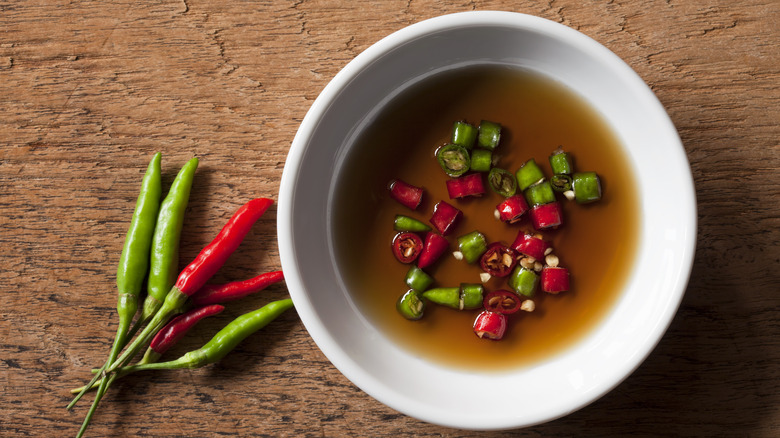What You Need To Know When Shopping For A Quality Fish Sauce
Now that anchovies are not the polarizing ingredient they once were, it has become easier for yet another briny ingredient to come to the forefront: Fish sauce. Popular and integral in many Southeast Asian cuisines, it is known by various names, among them nam pla in Thailand, nước mắm in Vietnam, and patis in the Philippines. Fish sauce also has a history during ancient Roman times, known in the region as garum.
Similar to anchovies, fish sauce does not quite give a fishy flavor, per se. Instead, it adds a savory depth to dishes, a hum of umami that is due to the high amount of glutamates it contains. Too much and it can make your food way too funky, but without it, your Southeast Asian stir-fries will be missing a certain and important X factor.
So how do you choose a quality fish sauce? As with many items on a supermarket shelf, the shorter the list of ingredients, the better. If the first ingredient on the label is not some form of fish, move on to another brand that says so. Make sure as well that it does not have any superfluous ingredients like added MSG, preservatives, or other additives.
What exactly is fish sauce?
All you really need to make fish sauce is fish, salt, and time. Many labels will also state that it contains water, which is actually the liquid that is naturally released from the fish as they ferment. Lower-grade fish sauce also tends to contain added sugars, and it's best to avoid these as well. You will have more control over the sweetness of a dish by adding your own sugars during the cooking process.
Higher quality fish sauce will also state a number on their label followed by the letter "N". This is to indicate the nitrogen levels within, and the higher the number, the better. According to South China Morning Post, high-grade fish sauce is anything above 30N and most fish sauce on the market is around the mid-20N range.
Another thing to look for on the label is if it mentions which pressing the fish sauce is taken from. Much like pressing oil, the first press is the purest, followed by less and less flavorful pressings that are topped up with more and more salt.
How to use different grades of fish sauce
Since different pressings of fish sauce are of different qualities, you can take advantage of this for different uses. High-grade fish sauce is best used where its flavor is prominent, such as in dips or dressings, as the complexity of the flavors will not get muddled or cooked off. Try it in this versatile chili-lime dressing that can be used for everything from grilled meats to fresh salads, or to add a pump to creamy dips like an umami guacamole recipe.
Lower-grade fish sauce can still have an important place in your cooking repertoire by using it in combination with other sauces in stir-fries and curries. As fish sauce is not the dominant flavor of these dishes, take advantage of its briny tang to counter deeper flavors. Use it in Thai green curry, or even in meaty pasta sauces — just do not tell your nonna!


